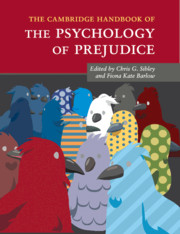Book contents
- Frontmatter
- Dedication
- Contents
- List of Figures
- List of Tables
- Notes on the Contributors
- Part I General Theoretical Perspectives
- Part II Prejudice in Specific Domains
- 11 Understanding the Nature, Measurement, and Utility of Implicit Intergroup Biases
- 12 Aversive Racism and Contemporary Bias
- 13 Ambivalent Sexism in the Twenty-First Century
- 14 Sexism in Intimate Contexts: How Romantic Relationships Help Explain the Origins, Functions, and Consequences of Sexist Attitudes
- 15 Religion and Prejudice
- 16 Sexual Prejudice: Advances in Conceptual and Empirical Models
- 17 Weight Bias: Prejudice and Discrimination toward Overweight and Obese People
- 18 Prejudice Against Immigrants in Multicultural Societies
- 19 Generalized Prejudice: Old Wisdom and New Perspectives
- Part III Prejudice Reduction and Analysis in Applied Contexts
- Index
- References
18 - Prejudice Against Immigrants in Multicultural Societies
from Part II - Prejudice in Specific Domains
Published online by Cambridge University Press: 17 November 2016
- Frontmatter
- Dedication
- Contents
- List of Figures
- List of Tables
- Notes on the Contributors
- Part I General Theoretical Perspectives
- Part II Prejudice in Specific Domains
- 11 Understanding the Nature, Measurement, and Utility of Implicit Intergroup Biases
- 12 Aversive Racism and Contemporary Bias
- 13 Ambivalent Sexism in the Twenty-First Century
- 14 Sexism in Intimate Contexts: How Romantic Relationships Help Explain the Origins, Functions, and Consequences of Sexist Attitudes
- 15 Religion and Prejudice
- 16 Sexual Prejudice: Advances in Conceptual and Empirical Models
- 17 Weight Bias: Prejudice and Discrimination toward Overweight and Obese People
- 18 Prejudice Against Immigrants in Multicultural Societies
- 19 Generalized Prejudice: Old Wisdom and New Perspectives
- Part III Prejudice Reduction and Analysis in Applied Contexts
- Index
- References
Summary
Migration is one of the most ancient traditions of humankind. From the beginning of human history, people have been moving places and crossing cultural and societal borders to search for new opportunities and a better life or to flee from war and natural disasters. Although migration is not a modern phenomenon, because of recent technological advancements in communication and transportation, moving across countries has become easier than ever before. This has resulted in a marked worldwide increase in the migrant stock over the past 50 years. In 2013, more than 230 million people were living as international immigrants, and it is projected that the migrant population will reach 400 million by 2050 (Martin, 2013).
Globally, four major migration pathways can be identified. The largest exchange (36%) occurs between regions of the Global South, that is, people from less affluent countries moving to other undeveloped regions. The second largest flow (35%) goes from the Global South to the Global North, that is, people from undeveloped regions migrating to the developed world. It is worth noting that the South to North migration continues to rise and is soon expected to become the primary trend. International relocation within the Global North is also considerable (23%), whereas North to South migration contributes only a small proportion (6%) to the global trends. Although there are no notable gender differences in migration trends, age appears to be a significant factor. Of all immigrants, 15% are younger than age 20, and approximately 74% belong to the working-age population. In sum, the majority of international immigrants (59%) currently reside in the developed world, where, according to recent statistics, migration has become the primary source of population growth, highlighting its growing significance in terms of economic prosperity and sustainable social development (UN, 2013).
At the same time, it is important to recognize that migration is not just an economic matter; it also has important implications for individuals and societies. As a result of globalization, demographic expansion, and increasing diversity within and across nations, plural societies are facing a wide range of social issues stemming from a multicultural reality, in which firsthand intercultural contact is an indispensable part of everyday experiences. Navigating these multiethnic contemporary societies has become increasingly complex and challenging, fostering public resistance to immigration and negative intergroup attitudes.
- Type
- Chapter
- Information
- The Cambridge Handbook of the Psychology of Prejudice , pp. 413 - 437Publisher: Cambridge University PressPrint publication year: 2016
References
- 10
- Cited by



